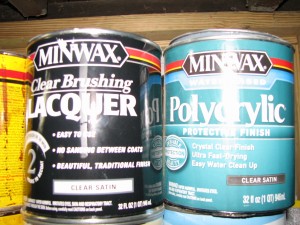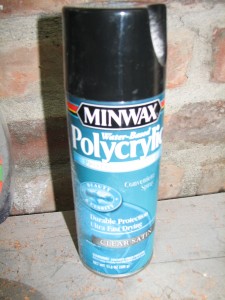Have you spent hours and hours working on a piece of furniture, got to the final step of sealing the piece, and the Polycrilic turned your piece yellow in spots? I’ve read so much about the fact that you shouldn’t use polyurethane on anything light in color because it will turn yellow (or ember) over time. Well, I just did 4 different pieces in four different styles and paint types and then had the polycrilic yellow. Everything I have read online says it should never yellow! I took the gallon of Minwax polycrylic back and was told that it says right on the back of gallon that it can ember. I couldn’t believe it, so the nice guy actually read it to me. I haven’t been able to find much online about this problem so I thought I would share my frustration, find out if any of my readers have have had this problem and found a solution, as well as offer a couple of ideas that have worked for me since then.
The guy at Home Depot recommended that I try Minwax Lacquer instead. Here’s what that looks like next to the polycrylic that I bought to replace the gallon that I believed to be bad.
 a
a
He said lacquer will never ember. I didn’t really like this solution because it isn’t water based so it stinks, ruins my brushes and really should be done outside. I can’t always do that here in the Northeast – thanks to winter or rainy weather, which we’ve had a lot of lately!
So, stubborn me used the Polycrylic again on another furniture piece (why didn’t I learn my lesson already?). This piece was BEAUTIFUL and I was so excited about it. I used the carefully stirred (don’t shake it) polycrylic and started applying it to the dresser. It started turning yellow again. I could NOT believe it. I walked away before I lost my cool. I searched online again thinking I could find a way to fix this problem, to no avail. (Maybe you all have found a good article or tips on polycrylic – if so, please share!). Once I recovered from my angst, I stopped and thought about the fact that God cares about the little things in our life. So, I prayed about what to do. I really believe He gave me the wisdom to try this. I just grabbed a spray bottle and did a 1 part white vinegar to 10 part water mixture. While the polycrylic was just a little tacky (mostly dry) I sprayed it lightly with the mixture and wiped it down with a clean clothe. It took the yellow right off and it has never returned. And- it still left a protected layer over the paint. This technique has worked for me about 4 times since so I feel comfortable sharing it.
For surfaces that don’t get much wear and tear, I’ve started using spray Polycrylic. It’s much more expensive, but I’ve found it goes for a long time. I have covered about 6 pieces and I’m still on the same can.

It dries much faster, too! I just wanted to share one of my mistakes that has happened along the way to hopefully save you some time and frustration. I would love to get your feedback on this problem!
Blessings!
Sarah
If you like what we’re doing, please like us on Facebook at: www.facebook.com/funcycled or share this on Pinterest! Also, you can now get each of our new projects emailed to you when you enter your email address in the box at the top right side of this page.
